In Bach you will find everything. —Johannes Brahms
Johann Sebastian Bach sits at the top of every musician’s forever playlist. And Bach’s B Minor Mass is widely considered the apex of his work for voice and instruments.
A dazzling summary of Bach’s technical genius, the B Minor Mass overflows with stylistic variety, intricate composition and crystalline counterpoint. Finished late in his life, Bach considered it to be a legacy work, an electrifying summary of his countless innovations, his gift to the future of Western music.
As Picasso is to visual art, so Bach is to music—everyone who came after him was influenced by his vision. A performance of this ultimate work for chorus, soloists and symphonic orchestra is rare. But we have two chances to hear it, at the Santa Cruz Civic Auditorium on May 4 and at Watsonville’s Mello Center on May 5.
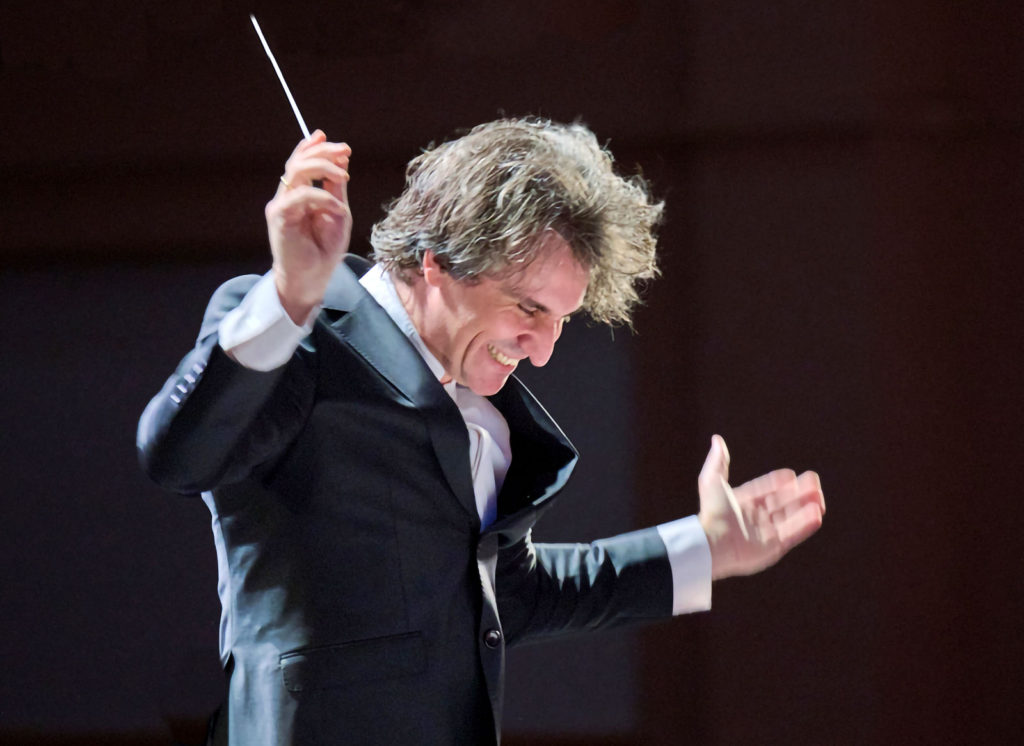
The Conductor: Daniel Stewart
A ten-year contract with his Santa Cruz orchestra and a new residence in the Bay Area demonstrate music director Daniel Stewart’s commitment to local audiences. The maestro is now adding to his résumé his first-ever B Minor Mass. No stranger to massive musical works, Green recently guest conducted Beethoven’s Symphony No. 9 with the San Francisco Symphony at the invitation of Esa-Pekka Salonen, and he is passionate about the upcoming Bach performances.
Good Times: How do you approach something this big?
DS: I haven’t had the pleasure of doing the B Minor Mass and the upcoming concerts are more special for that reason. So I made sure to really immerse myself in the operatic and the choral repertoire. Working with the Metropolitan Opera, for example, I have learned truly what it is to bring disparate forces together over a great physical space.
A non-musician might think of it in terms of coordinating a complex choreography on a big physical scale. I mean, when you see something happening, at halftime at a football game, there’s a lot of space involved and a lot of things going on. But they’re coordinated to one very metronomic beat yet with subtlety and nuance and flexibility.
I have to ask: why the excitement over the B Minor Mass?
DS: Well, Bach is such a singular force of musical, cultural influence. If you were to look for a similar figure in the world of painting, you’d almost have to roll Leonardo and Michelangelo, plus some others, into one. It’s just astonishing how influential and how visionary this one particular person is. And then you have to realize that the B Minor Mass is literally the summation and culmination of Bach’s work.
The material was taken from so many different parts of his life. He wrote five new pieces of material and he reworked some from 20 years before. It really is a summation of genius.
The music is so transformational, inspiring and brilliant, and it works so well in so many different arrangements, from small ensemble to symphony. This conversational, give-and-take counterpoint is the study of balance between musical ideas. And that makes it universal, enduring and so just astonishingly simple—deceptively simple.
How will this piece appeal to a younger audience? A first-time listener?
DS: To be in the presence of wonderful music, there’s no way you’re not going to find delight. And surprise, and wonder. We just have preconceptions, and that’s why I think we need our open rehearsals so that people come in and see the process. We can tie ourselves in knots over how to repackage classical music, but the essential aspect of it is there’s nothing that needs changing. It’s just the perception of it and access to it. If you hear magnificent classical music, it’s resonant. Because music itself speaks so eloquently for itself.
What size orchestra will you be using?
DS: We’ll be using close to our regular complement of musicians, probably about 60 positions. The majority of instruments will be strings, so you’ll see a slightly smaller version of our orchestra than normal.
Can you talk a little about the particular challenges of producing the B Minor Mass?
DS: The main factor is rehearsal time. We have such a very limited amount of time available to rehearse and so that’s always the greatest challenge. But as far as stamina and energy and all that goes, certainly you have to prepare the singers. The time involved—it’s over two hours—brings athletic challenges. But then again there are operas that last five hours! Musicians are more than capable and remarkably athletic in terms of their stamina, their preparation, their focus and their behind-the-scenes magic, creating a seamless and elegant presentation.
Have you discovered some special pleasures that you didn’t anticipate?
DS: Everyday, everyday, overwhelmingly beautiful, overwhelmingly inspiring, it’s the kind of experience that you get in the best moments in nature. You’re just absolutely in awe of the majesty of this. It makes you feel grateful to be alive.
Do you audition the soloists?
DS: Yes, yes, that’s one of my great privileges because I get to not only design the menu for each concert and for each year, you know, in terms of what, what we’re going to offer, but I very, very carefully cast all of the soloists and all of the performers involved. Coming from the Metropolitan Opera, I am fortunate to have many friends among leading musicians. So we’ve brought in some of the world’s greatest singers, and it’s just such a joy to introduce them to our lovely town.
We’ll have a superstar soprano, Hera Hyesang Park—her career is really taking off. And two other dear friends, Andrew Stenson and Sarah Couden, will join us, and Christian Pursell. Cheryl Anderson brought him to my attention. I was just absolutely delighted to see what an accomplished young artist he is. And so I could not miss that opportunity to really tie in his very special local origin story to this performance.
Do you ever get stressed about whether it will all come together?
DS: No, because I plan it so meticulously. And I don’t want to leave anything significant up to the risk of not being ready, but that being said, I think Picasso said have no fear of perfection, you’ll never reach it. But we’re always striving towards that. This is how we bring about transformative experiences, life-changing moments.
And you’re working once again with Cheryl Anderson.
DS: How wonderful it is to have a collaborator of her caliber, of her vision, of her heart. She’s one of my favorite musicians I’ve ever had the pleasure of working with and I’ve enjoyed more than I can say our many collaborations.
So it’s a special relationship that the chorus and the symphony have with one another and so much of that is because of the tremendous cultivation that Cheryl has put into the whole vocal world here. It’s been a rich relationship and a rich collaboration.
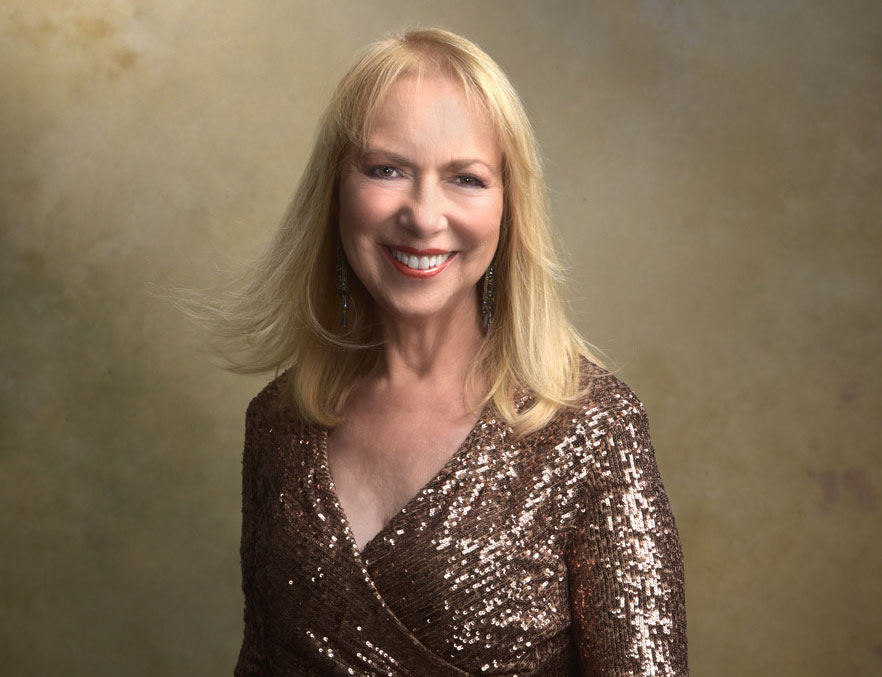
The Choral Director: Cheryl Anderson
Cheryl Anderson has had her expert hand in all phases of Monterey Bay area musical life. As director of Cabrillo College’s Choral and Vocal Studies program, she works in concert with the Santa Cruz Symphony for a major concert each spring. This year she has prepared her chorus of 85 voices for the B Minor Mass, the ultimate thrill for choral singers.
Tell me a little bit about your history with this piece.
CA: We did the B Minor at the Cincinnati Conservatory. We did every major Bach work. And then we had the pleasure of having Robert Shaw conduct us at the Conservatory, and that was so life-changing. It’s your north star really, but not just the music—the whole experience. Basically it’s embedded in my DNA. Coming to Cabrillo was the first time I had the kind of depth of personnel that I felt could really handle it. We did it at Holy Cross, and at the Mission and then at Peace United. Maybe 15 years ago. When Danny took me aside and said, “What would you think about the B Minor with the Symphony,” I just screamed! Wow!
Will you need to edit this piece?
CA: We don’t cut anything. It’s one of those pieces, for people who know the work, it would be like cutting off the bottom six inches of the Mona Lisa.
How do you prepare for something this huge?
CA: It’s not ostensibly different from other pieces that we do. We begin rehearsals with a warm-up, of course, and then we do about two hours of singing together. Then we split up, and anything that was egregiously difficult, we work on, in sectionals. We spend about an hour in sectional, so about three hours and 15 minutes.
At what point will your chorus begin working with the musicians?
CA: Danny generally comes the week before we start working with instrumentalists, about two weeks before concert. Then a week before, we get together for the first time with the orchestra at the Civic. So four meetings with musicians and conductor before concert.
Are you looking forward to this epic event?
CA: Oh, my God. I am so thrilled. I’m just beyond elated. I will hate for it to be over.
Is it hard to give the directing over to the conductor?
CA: No—that’s why I work with people that I adore and have faith in. And I get to sing. I always try to sing with them. I love it.
What are your favorite parts?
CA: Well, I love the Gloria—the Gloria’s where I learned that Bach dances.
And when the tenors and basses come in at the et aeternum—it’s a game changer. There’s nothing like it—nothing. As a group, they take over for four pages in this melismatic firestorm of beauty. [A melisma is an ornamental vocal technique involving one syllable sung across multiple notes.] It’s spectacular. That’s the first thing I rehearsed. What in the world caused him to write that for a bass section that just like a train came through the middle of the mass. It sounds like, “Now we’re celebrating!”
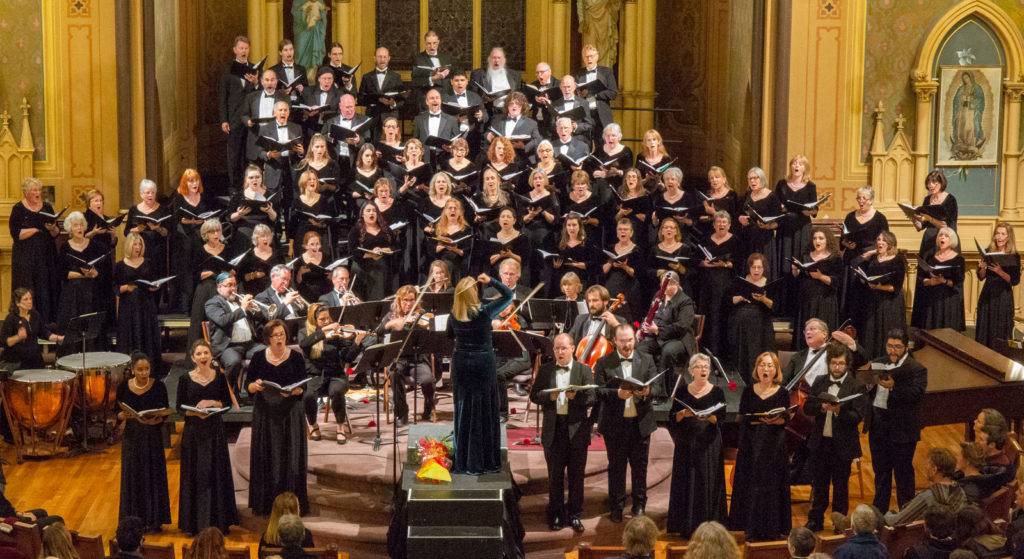
Any special vocal exercises for this work?
CA: They need the vocal agility to be able to sing that many fugues with that many melismas—it’s a huge deal for singers. We do a lot of agility exercises. This may be too technical, but I like to do a tongue trill on a very fast passage of so fa mi re do on the solfeggio and up to re and all the way back. And we do that once and then you take a breath and do two of them and then 3, of them, 4,5,6 of them to test the ability of your breath to manage the notes that are coming up. The management of breath that allows the tone to remain alive.
I’m there for coaching soloists often on a Tuesday afternoon of the first rehearsal. I have to mention the bass soloist, Christian Pursell, who graduated from Cabrillo. And then Cincinnati Conservatory. He’s been at the Met; he sang in San Francisco Opera, with the Mormon Tabernacle and the Montreal Symphony. He’s really been all over the world. He is very young. And he’s just brilliant.
What is the biggest challenge of presenting the B Minor Mass?
CA: I think endurance. And it’s physical and it’s mental and emotional. And so, we try to front load every single note so that it becomes almost second nature. You turn the page and you already know what’s going to be on the next page.
Do you ever have fearful moments about readiness?
CA: I would be lying if I said, no, no, I never have. But then I just look at a particular angle or what I might not have prepared well enough. At this point in my life, having done this as long as I have, I realize that when people come to work on this music it’s because they want to be there. They’re there to learn and to participate in something they couldn’t find in any other life experience.
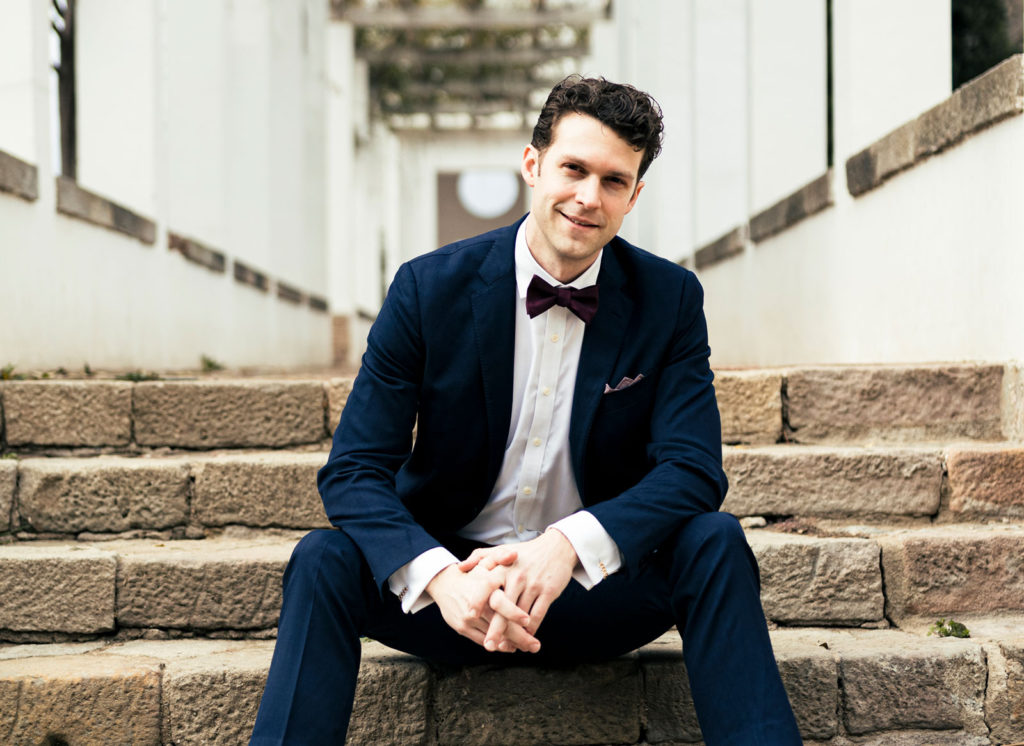
The Soloist: Christian Pursell
Bass/baritone Christian Pursell, who began his musical studies at Cabrillo College under the tutelage of Cheryl Anderson, now travels across the country developing his career in opera. The critically acclaimed singer recently made his Carnegie Hall debut in The Grapes of Wrath with MasterVoices. Delighted to be coming home to sing his very first B Minor Mass, Pursell talked about his hopes for the upcoming performance.
What’s exciting about this concert?
CP: I love doing Bach. Ever since high school when I was one of the Young Artists winners at Carmel Bach Festival. This piece is Bach’s version of the complete artwork. There’s amazing four-part harmony in Bach’s choral writing that just can make you cry. There’s really nothing like his harmonic progression. That’s the reason why in school students learn all about Bach, because his composition level is unmatched. Such stunning, beautiful music. I have two arias in the work, my chance to contribute. It’s a big project and I’m just one piece in it.
How do you prepare for a concert like this?
CP: Well, I scale my voice to each unique situation. In this case, I know the Santa Cruz Symphony, and the Civic Auditorium is a large, wide space. So I’m going to be aiming my voice toward various areas, using power in my voice. But the acoustics are very much in the favor of singers. I’m surprised at how good the acoustics are at the Civic. So the audience can hear everything. I would treat this as any opera gig with an orchestra. I’m going to be projecting my voice, and within that projection I will add as many colors as possible. This is kind of gesamptkunstwerk, a very grand piece of music that is bringing all these musical forces together.
At what point will you work with the orchestra?
CP: We will be just a couple of days in rehearsal. And it’s a large work so there’s going to be limited opportunities for me to run the piece. Typically what happens with a symphony gig is there’ll be a meeting with the conductor and the soloists to go over all the solo material with a pianist and run technical details. Tempi, where a rubato or fermata will be—all those details are taken care of with the orchestra. And as with all professional musicians, we’re ready to go at the first orchestra rehearsal. Then it’s just fine-tuning. So if we’re all prepared, then the better chance we get to be artistic and musical and make the Bach even more special.
How do you prepare for your solos? Do you sit at a keyboard and work through the material?
CP: Yes, absolutely. I grew up a pianist and so I’m able to self accompany myself to a certain extent, but usually you need another pair of ears. So I’ll work with a coach. In this case, I know the piece very well since I actually performed it last year in San Francisco. So this is a piece very familiar to me and close to my heart. And so I’ll review it, make sure that I’m pronouncing everything well and not missing any notes, and then just show up ready to perform.
And what’s next? Are you working in an opera this summer?
CP: Yes, that will be at Cincinnati Opera, where I’m singing in Don Giovanni, the role of Leporello. This is my first time doing it. I spent over a week this last month in Milan coaching the role with three different Italian coaches. So I’m feeling prepared. Not memorized yet. But prepared.
Are you looking forward to coming here to Santa Cruz to sing?
CP: I feel very close to Cheryl [Anderson]. She was a great mentor and a big supporter. I’ve always wanted to perform with my hometown symphony. And this is my first time doing it. So I’m so excited. A coming home moment!
The Santa Cruz Symphony presents Bach’s B Minor Mass in collaboration with the Cabrillo Symphonic Chorus and four renowned vocalists. Saturday, May 4, 7:30pm at the Civic Auditorium and Sunday May 5 2pm at the Mello Center for Performing Arts. santacruzsymphony.org


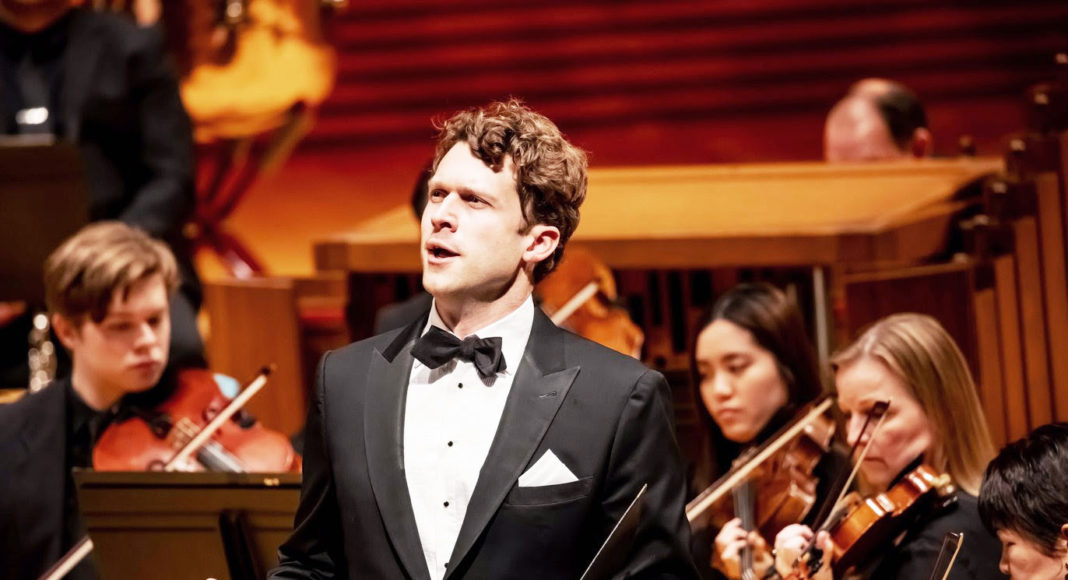











Christian Pursell is an amazing young voice. So delighted that he is coming home to perform Bach.
Local boy makes good, right Deanna? We had the privilege of singing with him in the TLC choir when he joined us at age 13! Dan and I will be at Mello Center Sunday afternoon.